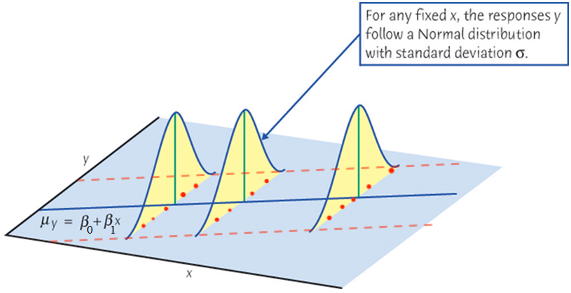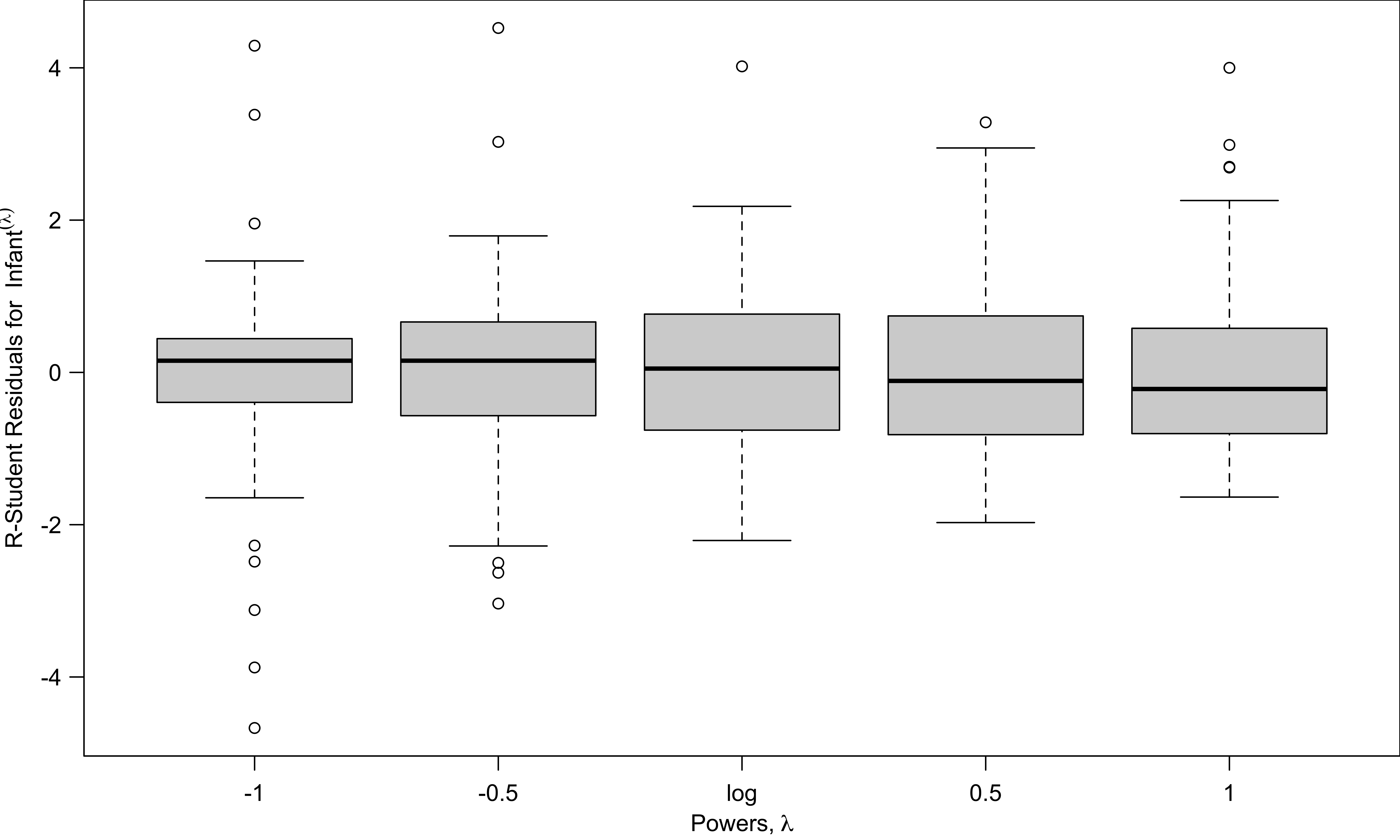
Regression Diagnostics: Normality 📖
MATH 4780 / MSSC 5780 Regression Analysis
Department of Mathematical and Statistical Sciences
Marquette University
Assumptions of Linear Regression
\(Y_i= \beta_0 + \beta_1X_{i1} + \beta_2X_{i2} + \dots + \beta_kX_{ik} + \epsilon_i\)
- \(E(Y \mid X)\) and \(X\) are linearly related.
- \(\small E(\epsilon_i) = 0\)
- \(\small \mathrm{Var}(\epsilon_i) = \sigma^2\)
- \(\small \mathrm{Cov}(\epsilon_i, \epsilon_j) = 0\) for all \(i \ne j\).
- \(\small \epsilon_i \stackrel{iid}{\sim} N(0, \sigma^2)\) (for statistical inference)
- If the assumptions are violated, a different sample could lead to a different conclusion!
- \(R^2\) tells us how good the model is fitted to the data, but says nothing about the correctness of the model.
- All the inferences are based on the assumption that the model is correct.
Model Adequacy Checking and Correction
Non-normality
Non-constant Error Variance
Non-linearity and Lack of Fit
Non-normality
- The central limit theorem assures the validity of inferences based on the least-squares (LS) coefficients in all but small samples.
Without normality,
-
Heavier tailed errors:
- LS estimators do not have the smallest variance among unbiased estimators.
- give rise to outliers.
-
Skewed errors:
- tend to generate outliers in the direction of the skew.
- the conditional mean of \(y\) given \(x\) is not a good measure of center of a highly skewed distribution.
-
Multimodal errors:
- suggest the omission of one or more categorical regressors.
Detecting Nonnormality
The R-student residuals \(t_i \sim t_{n-p-1}\) if the model assumptions are correct.
Compare the distribution of the \(t_i\)s to \(t_{n-p-1}\) in QQ plot.

QQ plot of R-Student Residuals Comparing \(t_{n-p-1}\)

Density plot of R-Student Residuals

Correcting Nonnormality
A response that is close to normal usually makes the assumption of normal errors more tenable.
-
Heavier tailed errors:
- Use robust regression (Chap 15 in LRA)
-
Skewed errors:
- Transform response data for symmetry
-
Multimodal errors:
- Add one or more relevant categorical variables.
Want the error or the response conditional on \(x\)s to be like normal after correction.
Transformation for Symmetry
Power transformation: \(y \rightarrow y^{\lambda}\)
- make the distribution of \(y\) more normal, at least more symmetric.
- \(y\) can take on positive values only.
- \(y \rightarrow \ln(y)\) for \(\lambda = 0.\)
Ladder of powers and roots (Tukey, 1977):
- No transformation: \(\lambda = 1\)
-
Descending: spreads out the small values of \(y\) relative to the large values.
- \(\lambda = 1/2\) (square root); \(\lambda = 0\) (natural log); \(\lambda = -1\) (inverse)
-
Ascending: spreads out the large values relative to the small values.
- \(\lambda = 2\) (square); \(\lambda = 3\) (cube)
The order of \(y\) is reversed if \(\lambda < 0\) is used for power transformation.
Correcting Skewness by Power Transformation


Box-Cox Transformation on \(y\)
A modified power transformation by Box and Cox (1964):
\[y^{(\lambda)} = \begin{cases} \frac{y^{\lambda}-1}{\lambda}, & \quad \lambda \ne 0\\ \ln y, & \quad \lambda = 0 \end{cases}\]
- For all \(\lambda\), \(y^{(\lambda)} = 1\) at \(y = 1\).
- The order of the transformed data \(y^{(\lambda)}\) is the same as that of \(y\), even for \(\lambda < 0.\)

Box-Cox Transformation on \(y\): Choose \(\lambda\) Analytically
- The model to be fit is \[y_i^{(\lambda)} = \beta_0 + \beta_1x_{i1}+ \cdots + \beta_kx_{ik} + \epsilon_i^*\]
- Choose \(\lambda\) so that the transformed errors \(\epsilon_i^*\) look as nearly normally distributed as possible.
R Lab CIA World Factbook Data
gdp infant gini health region
Albania 11.1 12.8 34 6.0 Europe
Algeria 14.3 21.0 35 5.2 Africa
Argentina 22.1 9.7 46 8.5 America
Armenia 7.4 13.5 31 4.5 Europe
Australia 46.6 4.4 30 9.1 Oceania
Austria 45.4 3.5 26 11.5 Europe
Azerbaijan 17.9 25.7 34 5.4 Asia
Bangladesh 3.4 44.1 32 3.6 Asia
Belarus 18.2 3.6 27 5.0 Europe
Belgium 41.7 3.4 26 10.8 Europe
Benin 1.9 55.7 36 4.5 Africa
Bhutan 7.7 35.9 39 3.8 Asia-
gdp: GDP per capita in thousands of U.S. dollars -
infant: Infant mortality rate per 1000 live births -
gini: Gini coefficient for the distribution of family income -
health: Health expenditures as a percentage of GDP
R Lab R-Student Residuals
- See how
gdp,healthandginiaffectinfant. - R-Student residuals are right-skewed, suggesting transforming the response, infant mortality, down the ladder of powers.

R Lab Box-Cox Transformation
Code
mat <- matrix(r_stud)
for (lam in c(0.5, 0, -0.5, -1)) {
refit <- update(
ciafit, car::bcPower(infant, lam) ~ .
)
mat <- cbind(rstudent(refit), mat)
}
colnames(mat) <- c(-1, -0.5, "log", 0.5, 1)
boxplot(
mat, id = FALSE,
xlab = expression("Powers," ~ lambda),
ylab = expression(
"R-Student Residuals for "
~ Infant ^ (lambda))
)
R Lab Choose \(\lambda\) Analytically
bcPower Transformation to Normality
Est Power Rounded Pwr Wald Lwr Bnd Wald Upr Bnd
Y1 -0.22 -0.33 -0.37 -0.072
Likelihood ratio test that transformation parameter is equal to 0
(log transformation)
LRT df pval
LR test, lambda = (0) 8 1 0.005
Likelihood ratio test that no transformation is needed
LRT df pval
LR test, lambda = (1) 181 1 <2e-16- \(\hat{\lambda} = -0.22\), and the \(95\%\) CI for \(\lambda\) is \([-0.37, -0.07]\).
- \(\lambda = 1\) not in the interval, providing support for transforming response.
- \(\lambda = 0\) (log transformation) is slightly outside the interval.
Other Issues
- Apply power transformations to data with zero or negative values by adding a positive constant to the data to make all values positive.
- \(\log(y + 10)\) if all \(y > -10\).
- Power transformations are effective when the ratio of the largest to smallest values is sufficiently large.
- If \(y_{max}/y_{min} \approx 1\), power transformations are nearly linear.
- Increase the ratio by adding a negative constant, \((y_{max} - c)/(y_{min}-c)\)
- If acceptable, choose log transformation for simple interpretation.
(Intercept) gdp health gini
3.016 -0.044 -0.055 0.022 - All else held constant, for one unit increase of
gdp, the infant mortality rate is expected to be decreased, on average, by 4.3% because \(\exp(-0.044) = 0.957\).